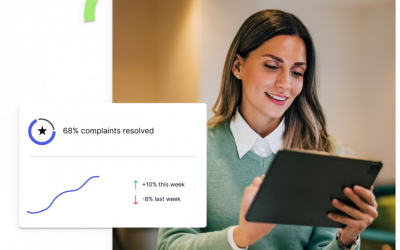In any relationship, people want to feel heard. The relationship between managers and employees is no exception, but the emphasis has traditionally been top-down—i.e., employees listening to management.
Employee listening, through surveys and other methods, adds more equilibrium by giving employees a voice in the workplace. Here’s what you need to know about employee listening and how a formalized employee listening strategy can benefit your business.
What is employee listening?
Employee listening is exactly what it says: the practice of taking the time to listen to your employees and understand their needs, wants, and concerns in the workplace.
Employee listening gives you insight into how your employees perceive their jobs, how motivated they are in their work, and what sort of changes they would like to see in the workplace. It can also provide valuable feedback on management performance and help you identify areas for improvement.
Passive vs. active listening
There are two main approaches to employee listening: passive and active.
Passive listening is more “hands-off” and involves collecting data on employee experiences without much direct interaction. Data like time spent in meetings, team size, frequency of 1-to-1 meetings with managers, and other metrics can be collected and used to gain broad insights into employee sentiment. Employers observe and identify potential issues and trends, which is particularly powerful when combined with AI analysis via a people analytics solution.
Active listening is when you solicit feedback from employees through surveys, polls, and other engagement tools, in addition to holding direct conversations with employees about their experiences. It allows you to have a better understanding of how employees view their jobs, what changes they would like to see in the workplace, and explore ideas they may have for improvement.
Both passive and active feedback are important to paint a full picture of what’s happening in your business.
How employee listening will strengthen your business
Employee listening has the potential to revolutionize your business and impact your bottom line by combining the quantitative data sourced from your HR systems with qualitative insights straight from your workforce. Let’s explore how.
1. Increased employee morale
A number of benefits spring from better employee morale. Happy employees are more productive employees; they stay with the organization longer, take ownership of their responsibilities, and contribute to creating a positive, collaborative work environment.
Taking the time to listen to employees, whether it’s through surveys or one-on-one conversation, makes them feel valued and respected. This will help boost their morale and the enthusiasm they have for their role in the company, making them more motivated on the job. You’ll also learn how they view their job and any issues or concerns they have, giving you the knowledge you need to bring about positive change.
2. Stronger management
When you listen to your employees, it’s not just about them—the process also holds up a mirror to your managers, giving them insight into their management styles and strategies.
Employee listening strengthens managers’ relationships with their team, facilitating more open communication.
When you’re listening to employees, you may not always like what you hear, particularly when feedback is sent through an anonymous survey. This is the best kind of feedback to get, though, as it’s the feedback that provides you opportunities for growth. It allows you to identify and address any problems before they become larger issues and demonstrate that your management team takes accountability.
3. Positive workplace culture
While businesses talk the talk about diversity, equity, and inclusion, employee listening is where they walk the walk.
By listening to employees and their experiences in the workplace, businesses can gain insight into any disparities or issues that may be affecting different groups of employees. This helps them identify areas for improvement and make meaningful changes that will create an inclusive work culture.
Employee listening also enables businesses to take a more proactive approach to tackling potential issues. It ensures that all employees feel supported and valued in the workplace, fostering a positive culture and creating an environment of trust, cooperation, and common goals. In turn, employees with a positive experience are sixteen times more engaged and eight times more likely to remain with their employer.
Put simply, employee listening truly sets the tone for your entire workplace, demonstrating the respect you have for the employee experience—and giving you positive business results through effective management and empowering employees to perform at their best.
Tools to gather employee feedback
Employee listening is not just limited to traditional forms of feedback like performance reviews. In order to effectively listen to employees, businesses need the right tools at hand.
There are a number of options available that can help businesses collect, track, and manage employee feedback.
Surveys, employee forums, and even social media can measure employee sentiment. This gives you a more thorough and broad understanding of the issues affecting employees in real-time, allowing you to better respond to any changes that need to be made.
While surveys are key, pairing them with tuned-in management is the other piece of the puzzle. No amount of surveys can overcome a manager that feels distant and uninterested. Management should be actively listening to employees every single day on the job.
Taking action: Putting feedback to use
Listening is one thing; taking action is another.
While employee listening provides great insights into employee needs and feelings, it’s important that businesses take those insights and use them to make meaningful changes in the workplace.
AI can serve as a bridge to connect feedback to action. Next generation people analytics platforms that have built-in AI can help businesses find deeper meaning from employee listening initiatives and surveys—you can combine business data and employee sentiment, then use AI people analytics to interpret this information into flight risk models and other metrics that help you turn your data into action.
By responding to employee feedback and taking action on concerns that are raised, businesses show that they value employees’ opinions and are committed to creating a positive work environment for everyone.
Connect with ZeroedIn
ZeroedIn is a people analytics solution with customized tools to help you make informed, data-driven decisions based on your employee listening strategy. Contact us today to get started.




